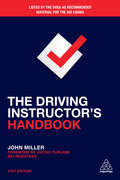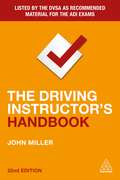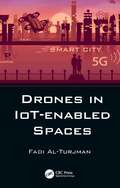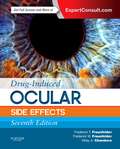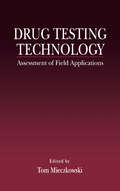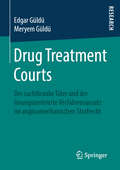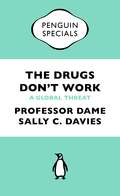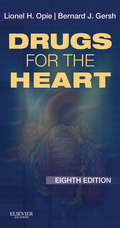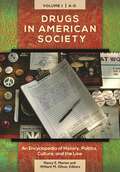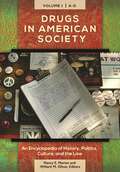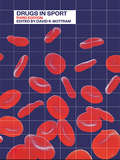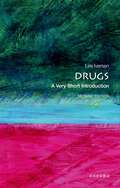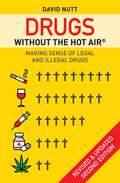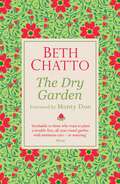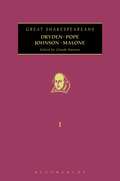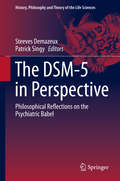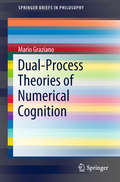- Table View
- List View
The Driving Instructor's Handbook
by John MillerNow in its 21st edition, The Driving Instructor's Handbook is widely recognized in the driver training industry as the authoritative reference guide for both trainee and qualified instructors and is listed by the Driver and Vehicle Standards Agency (DVSA) as recommended reading for the Approved Driving Instructor (ADI) exams.This best-selling text covers every aspect of the profession, from the role itself, to the characteristics needed to do the job effectively through the preparation for the three ADI exams (theory and hazard perception, driving ability and instructional ability). The Driving Instructor's Handbook also includes detailed guidance on issues such as licences, training, teaching and coaching skills and road traffic law and covers all 2016/17 changes to the ADI examinations and standards checks, including the most recent essential updates from late 2017. This handbook is essential reading for anyone involved in the training of drivers and instructors at all levels and will ensure that new drivers are better able to cope with the increasing demands made on them.
The Driving Instructor's Handbook
by John MillerRecognized by the Driver and Vehicle Stands Agency (DVSA) as recommended reading for the Approved Driving Instructor (ADI) exams, this bestselling guide is the authoritative guide for both trainee and qualified driving instructors. The Driving Instructor's Handbook covers every aspect of being a driving instructor, from the role itself, to the characteristics needed to the job effectively, through to preparation for the ADI exams. Now in its 22nd edition, the book includes detailed guidance on issues such as licences, training, teaching and coaching skills and road traffic law. Fully updated to cover all changes including updates to the ADI theory and practical tests, new rules in the Highway Code, revised motorway legislation, different rules and procedures in Northern Ireland and updated advice on disabilities, this book is essential reading for anyone involved in the training of drivers or driving instructors.
Drones in IoT-enabled Spaces
by Fadi Al-TurjmanThe Internet of Things (IoT) is a system of inter-connected devices, objects, and organisms. Among these devices, drones are gaining lots of interest. Drones are expected to communicate with cellular networks in the next generation networks (5G and beyond) which opens the door for another exciting research area. This book considers very important research areas in drone and cellular networks. It addresses major issues and challenges in drone-based solutions proposed for IoT-enabled cellular/computer networks, routing/communication protocols, surveillances applications, secured data management, and positioning approaches. It focuses mainly on smart and context-aware implementations.
Drones in IoT-enabled Spaces
by Fadi Al-TurjmanThe Internet of Things (IoT) is a system of inter-connected devices, objects, and organisms. Among these devices, drones are gaining lots of interest. Drones are expected to communicate with cellular networks in the next generation networks (5G and beyond) which opens the door for another exciting research area. This book considers very important research areas in drone and cellular networks. It addresses major issues and challenges in drone-based solutions proposed for IoT-enabled cellular/computer networks, routing/communication protocols, surveillances applications, secured data management, and positioning approaches. It focuses mainly on smart and context-aware implementations.
Drug-Induced Ocular Side Effects: Drug-induced Ocular Side Effects
by Frederick T. Fraunfelder Frederick W. Fraunfelder Jr. Wiley A. ChambersIdeal for ophthalmologists, optometrists and busy clinicians, Drug-Induced Ocular Side Effects provides the clinically relevant information you need to diagnose and manage chemical and drug-related ocular problems. An easily accessible format, meticulous revisions and comprehensive coverage of all drugs’ generic and trade names, primary uses, ocular and systemic side effects, and clinical significance make this best-selling resource the ideal reference for quick, on-the-spot consultation.Consult this title on your favorite e-reader, conduct rapid searches, and adjust font sizes for optimal readability. Manage any challenge in ocular toxicology with extensive coverage of principles of therapy; ocular drug delivery; methods to evaluate drug-induced visual side effects; and the role of electrophysiology and psychophysics. Benefit from the masterful guidance and global perspective of world authorities in the field who provide need-to-know information on all aspects of ocular toxicology—all in one concise reference. Confer with the WHO classification system to determine whether a particular side effect is certain, probable, or likely to occur. Zero in on the key information you need to know with highly templated, concise chapters. Apply the latest knowledge and treatments for newly recognized Adverse Drug Reactions (ADR). Identify which ADR’s are clinically relevant and what to do about them. Experience clinical scenarios with vivid clarity through a wealth of new and updated clinical photographs that provide unmatched, visual diagnostic guidance. Recognize and avoid drug-induced ocular side effects with data from the National Registry of Drug Induced Ocular Side-Effects (Casey Eye Institute, Portland, OR) and the World Health Organization (Uppsala, Sweden). Stay up to date and provide state-of-the-art care with the latest information on approved medications.
Drug Testing Technology: Assessment of Field Applications
by Tom MieczkowskiCovering a wide range of research currently being done in drug analysis, Drug Testing Technology: Assessment of Field Applications compares and evaluates various methods used to determine abused drugs taken by individuals, and their application in various programs and contexts. Controversies associated with various methods, including urine analysis and hair analysis, are examined. Contributors from a wide diversity of disciplines offer advanced knowledge, encompassing work which is technical as well as markedly philosophical. Chapters provide overviews of drug incorporation into hair; the use of hair analysis for compliance measurement in the use of anti-epileptic medications; and the application of drug testing to the psychiatric treatment of substance abuse disorders. Drug Testing Technology: Assessment of Field Applications provides information useful in medical applications, workplace testing, criminal justice monitoring community epidemiology, and drug treatment assessment.
Drug Testing Technology: Assessment of Field Applications
by Tom MieczkowskiCovering a wide range of research currently being done in drug analysis, Drug Testing Technology: Assessment of Field Applications compares and evaluates various methods used to determine abused drugs taken by individuals, and their application in various programs and contexts. Controversies associated with various methods, including urine analysis and hair analysis, are examined. Contributors from a wide diversity of disciplines offer advanced knowledge, encompassing work which is technical as well as markedly philosophical. Chapters provide overviews of drug incorporation into hair; the use of hair analysis for compliance measurement in the use of anti-epileptic medications; and the application of drug testing to the psychiatric treatment of substance abuse disorders. Drug Testing Technology: Assessment of Field Applications provides information useful in medical applications, workplace testing, criminal justice monitoring community epidemiology, and drug treatment assessment.
Drug Treatment Courts: Der suchtkranke Täter und der lösungszentrierte Verfahrensansatz im angloamerikanischen Strafrecht
by Edgar Güldü Meryem GüldüEdgar Güldü beleuchtet das Modell der Drug Treatment Courts und – gemeinsam mit der Co-Autorin Frau Meryem Güldü – die zugrunde liegende Rechtstheorie. Der Autor zeigt, dass es sich bei den als Drug Courts bezeichneten Gerichtsprogrammen um einen neuartigen Diversionsansatz gegenüber suchtkranken Straftätern in den USA und den Ländern des Common Laws handelt. Drogengerichte heben sich nach Auffassung des Autors gegenüber dem Therapievorrang in unserer Rechtsordnung durch die Einbindung der Strafverfahrensbeteiligten in den Behandlungs- und Resozialisierungsprozess ab. Damit stehen die Drogengerichtsprogramme für eine sogenannte Problem-Solving Justice, einen lösungszentrierten Verfahrensansatz, der bisher zu Unrecht kaum Beachtung erfahren hat.
The Drugs Don't Work: A Global Threat (Penguin Specials)
by Professor Dame Davies Dr Jonathan Grant Professor Mike CatchpoleThe Drugs Don't Work - A Penguin Special by Professor Dame Sally Davies, the Chief Medical Officer for England'If we fail to act, we are looking at an almost unthinkable scenario where antibiotics no longer work and we are cast back into the dark ages of medicine where treatable infections and injuries will kill once again' David Cameron, Prime MinisterResistance to our current range of antibiotics is the new inconvenient truth. If we don't act now, we risk the health of our parents, our children and our grandchildren.Antibiotics add, on average, twenty years to our lives. For over seventy years, since the manufacture of penicillin in 1943, we have survived extraordinary operations and life-threatening infections. We are so familiar with these wonder drugs that we take them for granted. The truth is that we have been abusing them: as patients, as doctors, as travellers, in our food.No new class of antibacterial has been discovered for twenty six years and the bugs are fighting back. If we do not take responsibility now, in a few decades we may start dying from the most commonplace of operations and ailments that can today be treated easily.This short book, which will be enjoyed by readers of An Inconvenient Truth by Al Gore and Bad Pharma by Ben Goldacre, will be the subject of a TEDex talk given by Professor Dame Sally Davies at the Royal Albert Hall.Professor Dame Sally C. Davies is the Chief Medical Officer for England and the first woman to hold the post. As CMO she is the independent advisor to the Government on medical matters with particular interest in Public Health and Research. She holds a number of international advisory positions and is an Emeritus Professor at Imperial College.Dr Jonathan Grant is a Principal Research Fellow and former President at RAND Europe, a not-for-profit public policy research institute. His main research interests are on health R&D policy and the use of research and evidence in policymaking. He was formerly Head of Policy at The Wellcome Trust. He received his PhD from the Faculty of Medicine, University of London, and his B.Sc. (Econ) from the London School of Economics.Professor Mike Catchpole is an internationally recognized expert in infectious diseases and the Director of Infectious Disease Surveillance and Control at Public Health England. He has coordinated many national infectious disease outbreak investigations and is an advisor to the European Centre for Disease Prevention and Control. He is also a visiting professor at Imperial College.
Drugs for the Heart E-Book
by Lionel H. Opie Bernard J. GershDrugs for the Heart presents highly portable, up-to-date information on every drug class used to treat cardiovascular disease. Drs. Lionel H. Opie and Bernard J. Gersh put the latest dosages, interactions, indications and contraindications, side effects, and more at your fingertips, equipping you to make effective clinical decisions on behalf of your patients. Consult this title on your favorite e-reader, conduct rapid searches, and adjust font sizes for optimal readability.Quickly check when to use each drug for any condition with the popular "Which Drug for Which Disease" chapter.Get expert advice from the practice-proven experience of two well-known editors who represent the best possible combination of clinical and research expertise in cardiovascular therapeutics.Expedite your reference with summaries of each drug class at the end of chapters.Carry it with you anywhere thanks to a highly compact, pocket-sized format.Navigate the latest pharmacologic advances through coverage of the newest drugs and drug classes, as well as all the latest clinical trial results and evidence used to treat heart disease.Effectively manage comorbid diseases.Apply international insights into cardiac drugs, thanks to new global contributors.Visualize key pharmacologic and physiologic actions thanks to dynamic new full-color drawings.
Drugs in American Society [3 volumes]: An Encyclopedia of History, Politics, Culture, and the Law [3 volumes]
by Nancy E. Marion and Willard M. Oliver, EditorsContaining more than 450 entries, this easy-to-read encyclopedia provides concise information about the history of and recent trends in drug use and drug abuse in the United States—a societal problem with an estimated cost of $559 billion a year.Despite decades of effort and billions of dollars spent to combat the problem, illicit drug use in the United States is still rampant and shows no sign of abating. Covering illegal drugs ranging from marijuana and LSD to cocaine and crystal meth, this authoritative reference work examines patterns of drug use in American history, as well as drug control and interdiction efforts from the nineteenth century to the present.This encyclopedia provides a multidisciplinary perspective on the various aspects of the American drug problem, including the drugs themselves, the actions taken in attempts to curb or stop the drug trade, the efforts at intervention and treatment of those individuals affected by drug use, and the cultural and economic effects of drug use in the United States. More than 450 entries descriptively analyze and summarize key terms, trends, concepts, and people that are vital to the study of drugs and drug abuse, providing readers of all ages and backgrounds with invaluable information on domestic and international drug trafficking and use. The set provides special coverage of shifting societal and legislative perspectives on marijuana, as evidenced by Colorado and Washington legalizing marijuana with the 2012 elections.
Drugs in American Society [3 volumes]: An Encyclopedia of History, Politics, Culture, and the Law [3 volumes]
Containing more than 450 entries, this easy-to-read encyclopedia provides concise information about the history of and recent trends in drug use and drug abuse in the United States—a societal problem with an estimated cost of $559 billion a year.Despite decades of effort and billions of dollars spent to combat the problem, illicit drug use in the United States is still rampant and shows no sign of abating. Covering illegal drugs ranging from marijuana and LSD to cocaine and crystal meth, this authoritative reference work examines patterns of drug use in American history, as well as drug control and interdiction efforts from the nineteenth century to the present.This encyclopedia provides a multidisciplinary perspective on the various aspects of the American drug problem, including the drugs themselves, the actions taken in attempts to curb or stop the drug trade, the efforts at intervention and treatment of those individuals affected by drug use, and the cultural and economic effects of drug use in the United States. More than 450 entries descriptively analyze and summarize key terms, trends, concepts, and people that are vital to the study of drugs and drug abuse, providing readers of all ages and backgrounds with invaluable information on domestic and international drug trafficking and use. The set provides special coverage of shifting societal and legislative perspectives on marijuana, as evidenced by Colorado and Washington legalizing marijuana with the 2012 elections.
Drugs in Sport
by David MottramDrug use and abuse represents perhaps the most profound and high-profile issue facing sport today. Each major international championship seems to deliver a new drug-related controversy, while drug takers and sports administrators attempt to out-manoeuvre each other with new substances and new testing procedures.Drugs in Sport - 3rd Editionis a fully revised and updated version of the most comprehensive and authoritative text available on the subject. Leading figures in the field explore the hard science behind every major class of drug, as well as the social, ethical and organisational dimensions to the issue.Key topics include:* analysis of all the key substances, including anabolic steroids, EPO and human growth hormone* alcohol and social drug use in sport* creatine and nutritional supplements* evidence and issues around doping control in sport.This is a highly accessible text for all sports science and sports studies students, coaches and professional sports people, and sports administrators and policy-makers.
Drugs in Sport
by David MottramDrug use and abuse represents perhaps the most profound and high-profile issue facing sport today. Each major international championship seems to deliver a new drug-related controversy, while drug takers and sports administrators attempt to out-manoeuvre each other with new substances and new testing procedures.Drugs in Sport - 3rd Editionis a fully revised and updated version of the most comprehensive and authoritative text available on the subject. Leading figures in the field explore the hard science behind every major class of drug, as well as the social, ethical and organisational dimensions to the issue.Key topics include:* analysis of all the key substances, including anabolic steroids, EPO and human growth hormone* alcohol and social drug use in sport* creatine and nutritional supplements* evidence and issues around doping control in sport.This is a highly accessible text for all sports science and sports studies students, coaches and professional sports people, and sports administrators and policy-makers.
Drugs: A Very Short Introduction (Very Short Introductions)
by Les IversenThe twentieth century saw a remarkable upsurge of research on drugs, with major advances in the treatment of bacterial and viral infections, heart disease, stomach ulcers, cancer, and mental illnesses. These, along with the introduction of the oral contraceptive, have altered all of our lives. There has also been an increase in the recreational use and abuse of drugs in the Western world. This Very Short Introduction, in its second edition, gives a non-technical account of how drugs work in the body. Reviewing both legal (alcohol, nicotine, and caffeine) and illegal drugs, Les Iversen discusses why some are addictive, and whether drug laws need reform. ABOUT THE SERIES: The Very Short Introductions series from Oxford University Press contains hundreds of titles in almost every subject area. These pocket-sized books are the perfect way to get ahead in a new subject quickly. Our expert authors combine facts, analysis, perspective, new ideas, and enthusiasm to make interesting and challenging topics highly readable.
Drugs: A Very Short Introduction (Very Short Introductions)
by Les IversenThe twentieth century saw a remarkable upsurge of research on drugs, with major advances in the treatment of bacterial and viral infections, heart disease, stomach ulcers, cancer, and mental illnesses. These, along with the introduction of the oral contraceptive, have altered all of our lives. There has also been an increase in the recreational use and abuse of drugs in the Western world. This Very Short Introduction, in its second edition, gives a non-technical account of how drugs work in the body. Reviewing both legal (alcohol, nicotine, and caffeine) and illegal drugs, Les Iversen discusses why some are addictive, and whether drug laws need reform. ABOUT THE SERIES: The Very Short Introductions series from Oxford University Press contains hundreds of titles in almost every subject area. These pocket-sized books are the perfect way to get ahead in a new subject quickly. Our expert authors combine facts, analysis, perspective, new ideas, and enthusiasm to make interesting and challenging topics highly readable.
Drugs without the hot air: Making sense of legal and illegal drugs (without the hot air)
by David NuttThe dangers of illegal drugs are well known and rarely disputed, but how harmful are alcohol and tobacco by comparison? The issue of what a drug is and how we should live with them affects us all: parents, teachers, users – anyone who has taken a painkiller or drunk a glass of wine. Written by renowned psychiatrist, Professor David Nutt, Drugs without the hot air casts a refreshingly honest light on drugs and answers crucial questions that are rarely ever disputed. What are we missing by banning medical research into magic mushrooms, LSD and cannabis? Can they be sources of valuable treatments? How can psychedelics treat depression?Drugs without the hot air covers a wide range of topics, from addiction and whether addictive personalities exist to the role of cannabis in treating epilepsy, an overview on the opioid crisis, and an assessment of how harmful vaping is. This new expanded and revised second edition includes even more details on international policies, particularly in the US. David's research has won international support, reducing drug-related harm by introducing policies that are founded on scientific evidence. But there is still a lot to be done. Accessibly written, this much-awaited second edition is an important book for everyone that brings us all up to date with the 'war of drugs'.
The Dry Garden
by Beth Chatto'I return to Beth Chatto's books constantly. For those who are new to her work, you are entering into a life-long relationship with a wise friend and gardener' Monty Don'Invaluable to those who want to plant a trouble-free, all-year-round garden with minimum care - or watering' FLORAIn today's climate of increasingly hot summers and dry winters, gardeners need guidance on plants that will thrive in dry conditions. In Beth Chatto's classic book, she uses plants that need very little attention and are naturally adapted to flourish in dry conditions to provide a year-round display of beautiful foliage and flowers. Drawing from her own immense experience, she provides valuable guidance on types of soil and on basic principles of design. She discusses the plants and plantings suited to dry conditions and includes a detailed list of plants, with notes and advice on their characteristics.
Dryden, Pope, Johnson, Malone: Great Shakespeareans: Volume I (Great Shakespeareans)
by Claude RawsonGreat Shakespeareans offers a systematic account of those figures who have had the greatest influence on the interpretation, understanding and cultural reception of Shakespeare, both nationally and internationally. In this volume, leading scholars assess the contribution of Alexander Pope, John Dryden, Samuel Johnson and Edmond Malone to the afterlife and reception of Shakespeare and his plays. Each substantial contribution assesses the double impact of Shakespeare on the figure covered and of the figure on the understanding, interpretation and appreciation of Shakespeare, provide a sketch of their subject's intellectual and professional biography and an account of the wider cultural context, including comparison with other figures or works within the same field.
Dryden, Pope, Johnson, Malone: Great Shakespeareans: Volume I (Great Shakespeareans)
by Claude RawsonGreat Shakespeareans offers a systematic account of those figures who have had the greatest influence on the interpretation, understanding and cultural reception of Shakespeare, both nationally and internationally. In this volume, leading scholars assess the contribution of Alexander Pope, John Dryden, Samuel Johnson and Edmond Malone to the afterlife and reception of Shakespeare and his plays. Each substantial contribution assesses the double impact of Shakespeare on the figure covered and of the figure on the understanding, interpretation and appreciation of Shakespeare, provide a sketch of their subject's intellectual and professional biography and an account of the wider cultural context, including comparison with other figures or works within the same field.
The DSM-5 in Perspective: Philosophical Reflections on the Psychiatric Babel (History, Philosophy and Theory of the Life Sciences #10)
by Steeves Demazeux Patrick SingySince its third edition in 1980, the Diagnostic and Statistical Manual of Mental Disorders (DSM) of the American Psychiatric Association has acquired a hegemonic role in the health care professions and has had a broad impact on the lay public. The publication in May 2013 of its fifth edition, the DSM-5, marked the latest milestone in the history of the DSM and of American psychiatry. In The DSM-5 in Perspective: Philosophical Reflections on the Psychiatric Babel, experts in the philosophy of psychiatry propose original essays that explore the main issues related to the DSM-5, such as the still weak validity and reliability of the classification, the scientific status of its revision process, the several cultural, gender and sexist biases that are apparent in the criteria, the comorbidity issue and the categorical vs. dimensional debate. For several decades the DSM has been nicknamed “The Psychiatric Bible.” This volume would like to suggest another biblical metaphor: the Tower of Babel. Altogether, the essays in this volume describe the DSM as an imperfect and unachievable monument – a monument that was originally built to celebrate the new unity of clinical psychiatric discourse, but that ended up creating, as a result of its hubris, ever more profound practical divisions and theoretical difficulties.
DTP- Desktop Publishing (Large Print)
by RnibDTP, newspaper, desktop, publishing, application, program, publication, text, text block, picture box, ICT, media studies
DTP- Desktop Publishing (UEB Contracted)
by RnibDTP, newspaper, desktop, publishing, application, program, publication, text, text block, picture box, ICT, media studies
DTP- Desktop Publishing (UEB Uncontracted)
by RnibDTP, newspaper, desktop, publishing, application, program, publication, text, text block, picture box, ICT, media studies
Dual-Process Theories of Numerical Cognition (SpringerBriefs in Philosophy)
by Mario GrazianoThis book presents a philosophical interpretation to numerical cognition based on dual process theories and heuristics. It shows how investigations in cognitive science can shed light on issues traditionally raised by philosophers of mathematics. The analysis will also help readers to better understand the relationship between current neuroscientific research and the philosophical reflection on mathematics. The author seeks to explain the acquisition of mathematical concepts. To accomplish this, he needs to answer two questions. How can the concepts of approximate numerosity become an object of thought that is so accessible to our consciousness? How are these concepts refined and specified in such a way as to become numbers? Unfortunately, there is currently no model that can truly demonstrate the role of language in the development of numerical skills starting from approximate pre-verbal skills. However, the author details a solution to this problem: dual process theories. It is an approach widely used by theorists focusing on reasoning, decision making, social cognition, and consciousness. Here, he applies this approach to the studies on mathematical knowledge. He details the results brought about by psychological and neuroscientific studies conducted on numerical cognition by key neuroscientists. In the process, he develops the foundations of a new, potential philosophical explanation on mathematical knowledge.
